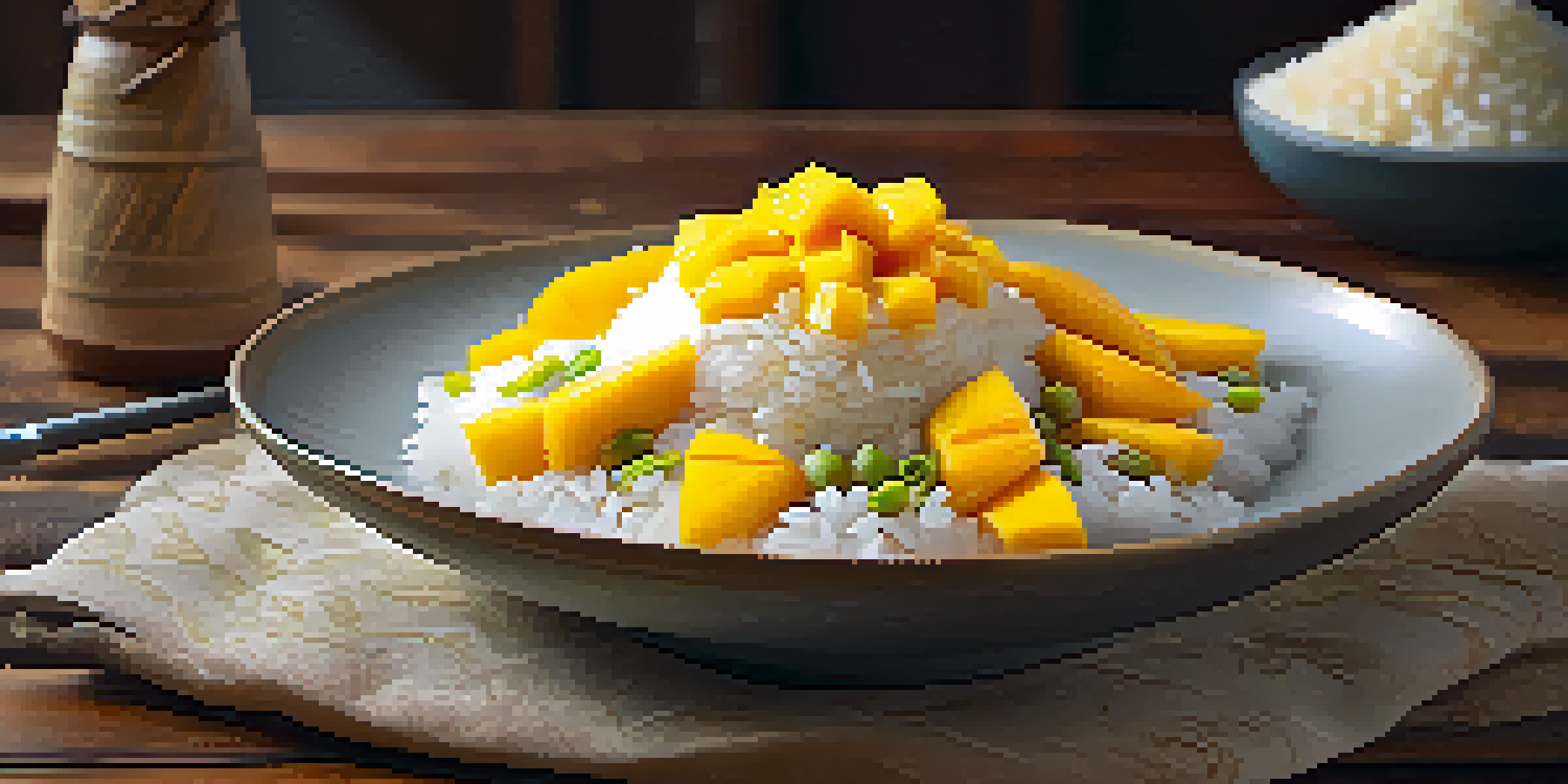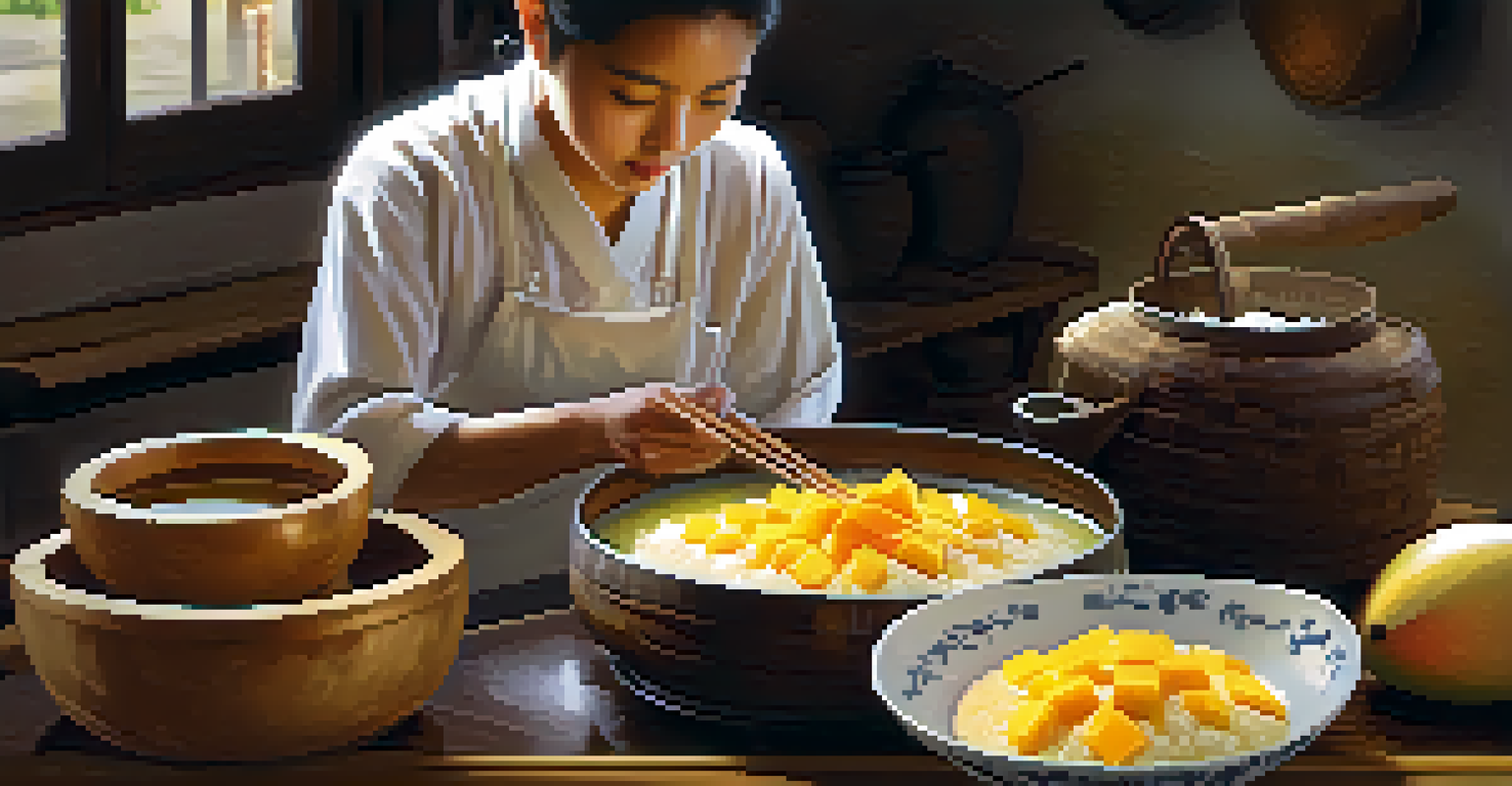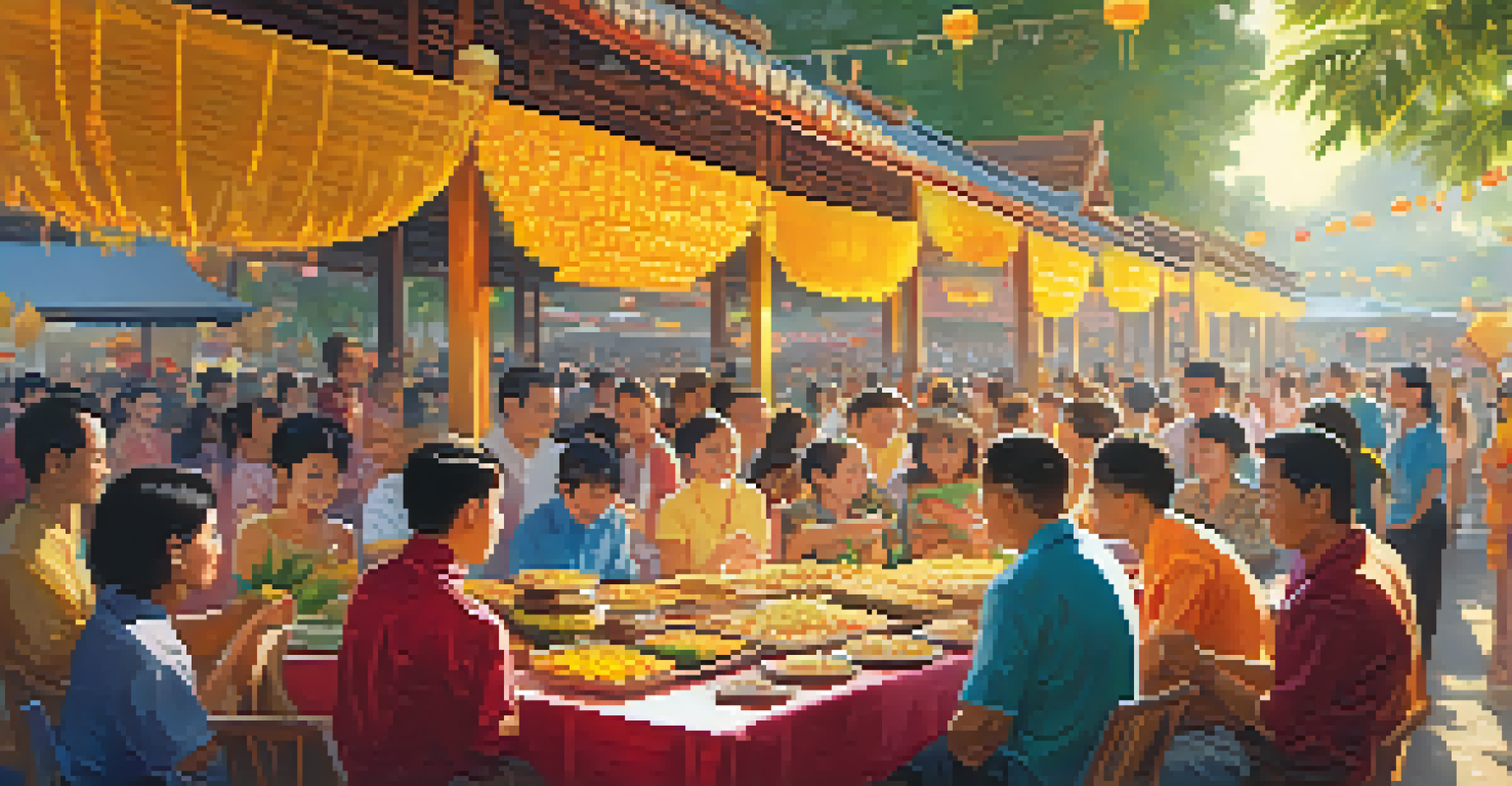Exploring the Origins of Mango Sticky Rice in Thai Culture

The Sweet Symphony of Mango Sticky Rice in Thai Cuisine
Mango sticky rice, known as 'Khao Niew Mamuang' in Thai, is a beloved dessert that beautifully blends sweet and savory flavors. This dish is a perfect representation of Thai culinary art, where each ingredient plays a vital role in creating a harmonious taste. The sticky rice, cooked to perfection, is complemented by the luscious sweetness of ripe mangoes, making it a favorite among locals and tourists alike.
Food is our common ground, a universal experience.
The combination of glutinous rice with fresh mangoes and a drizzle of coconut milk creates a textural contrast that delights the palate. It's not just about the flavors; the dish is often visually stunning, showcasing the vibrant yellow of the mango against the white sticky rice. This eye-catching presentation makes it a popular choice for celebrations and gatherings.
In many ways, mango sticky rice embodies the essence of Thai food: a balance of flavors, colors, and textures. It serves as a reminder of the importance of culinary traditions in Thai culture, where food is not just sustenance but a source of joy and community.
The Historical Roots of Mango Sticky Rice in Thailand
The origins of mango sticky rice can be traced back centuries, reflecting Thailand's agricultural practices and cultural exchanges. Sticky rice has been a staple in Thai diets for generations, particularly in the northern regions, where it is often used in various dishes. The introduction of mangoes, believed to have originated in Southeast Asia, brought a new dimension to the use of sticky rice in desserts.

Historically, mango sticky rice may have been prepared during special occasions and festivals, highlighting its significance in Thai culture. The dish's presence during celebrations showcases the Thai people's appreciation for seasonal fruits and their celebration of nature's bounty. This connection between food and tradition has helped the dessert evolve into a beloved staple across the country.
Mango Sticky Rice: A Thai Treasure
This beloved dessert blends sweet and savory flavors, showcasing the art of Thai cuisine.
Over the years, the dish has adapted to local tastes and preferences, with variations emerging in different regions. This evolution demonstrates the flexibility of Thai cuisine and its ability to integrate new ingredients while honoring traditional techniques.
Cultural Significance of Mango Sticky Rice in Thai Festivals
Mango sticky rice holds a special place in various Thai festivals, where it is often featured as a highlight on the menu. During the Thai New Year, known as Songkran, this dessert symbolizes good fortune and abundance, making it a must-have for the celebrations. The act of sharing mango sticky rice among family and friends fosters a sense of togetherness and community.
Cooking is like love. It should be entered into with abandon or not at all.
Moreover, the dish is commonly served during the annual Mango Festival in Thailand, where locals and tourists come together to celebrate this delicious fruit. The festival showcases a variety of mango-based dishes, with mango sticky rice taking center stage. This annual event not only promotes the fruit but also highlights the importance of culinary traditions in Thai culture.
The presence of mango sticky rice in such festivities underscores its role in Thai identity. It is a dish that resonates with nostalgia, often reminding individuals of their childhood and family gatherings, reinforcing the bond between food and cultural heritage.
The Ingredients Behind the Delight of Mango Sticky Rice
At its core, mango sticky rice is a simple dish made from just a few key ingredients, yet each one plays a crucial role in its overall flavor. The primary ingredient, glutinous rice, is soaked and steamed to create a chewy texture that pairs perfectly with the soft mango slices. The use of high-quality, ripe mangoes enhances the dish, providing natural sweetness and vibrant color.
Coconut milk is another essential component that adds creaminess and richness to the dish. When heated with sugar and a pinch of salt, it creates a luscious sauce that elevates the sticky rice to new heights. This balance of sweet and salty is a hallmark of Thai cuisine, showcasing the thoughtfulness that goes into crafting each dish.
Cultural Significance in Festivals
Mango sticky rice symbolizes good fortune during Thai festivals, fostering community and celebration.
Interestingly, variations of mango sticky rice can be found across different regions of Thailand, showcasing local ingredients and preferences. Some might add mung beans for crunch, while others might incorporate sesame seeds or coconut flakes for added texture, illustrating how a beloved dish can evolve while maintaining its essence.
Mango Sticky Rice: A Culinary Experience Beyond Taste
Enjoying mango sticky rice is not just about savoring its delicious flavors; it’s an experience that engages all the senses. The moment you open a box of mango sticky rice, the sweet aroma of ripe mangoes and coconut milk wafts through the air, inviting you to indulge. The contrasting textures of the creamy coconut sauce, the chewy sticky rice, and the tender mango create a delightful mouthfeel that is truly satisfying.
Moreover, the act of preparing mango sticky rice can be a communal experience, often bringing families together in the kitchen. From soaking the rice to steaming it and finally assembling the dish, each step is filled with anticipation and joy. This shared experience fosters connections and memories that extend beyond the meal itself.
Finally, serving mango sticky rice can be a form of artistic expression. The dish is often plated beautifully, with mango slices arranged elegantly atop the sticky rice, drizzled with coconut sauce, and sometimes garnished with sesame seeds. This attention to presentation reflects the Thai value of aesthetics in food, where visual appeal is just as important as taste.
Mango Sticky Rice: A Global Phenomenon
In recent years, mango sticky rice has gained immense popularity beyond Thai borders, becoming a beloved dessert in many parts of the world. Its unique combination of flavors and textures has captivated food lovers globally, leading to its inclusion in various international menus. This rise in popularity speaks to the universal appeal of Thai cuisine and its ability to resonate with diverse palates.
Food enthusiasts often seek out authentic Thai restaurants to experience this traditional dish, while chefs experiment with innovative twists on the classic recipe. From mango sticky rice ice cream to fusion desserts, the dish has inspired countless culinary creations that maintain its core elements while adding a modern twist.
Global Popularity of a Classic Dish
Mango sticky rice has transcended borders, captivating food lovers worldwide with its unique flavors.
Social media has played a significant role in spreading the word about mango sticky rice, with stunning food photography showcasing the dish’s beauty. This visual appeal, combined with its delicious taste, has made it a trending item on platforms like Instagram, further solidifying its status as a global phenomenon.
How to Make Mango Sticky Rice at Home
Creating mango sticky rice at home is a rewarding experience that allows you to bring a taste of Thailand into your kitchen. The process begins with soaking glutinous rice for several hours, which is the key to achieving the perfect texture. After steaming the rice, mix it with sweetened coconut milk to infuse it with flavor, letting it absorb the creamy goodness.
Once the rice has cooled, slice ripe mangoes into bite-sized pieces and layer them alongside the sticky rice on a plate. Drizzle additional coconut sauce over the top for an extra burst of flavor and don’t forget to sprinkle some sesame seeds or mung beans for a delightful crunch. This simple yet delicious dish can easily become a favorite for family gatherings or casual dinners.

Making mango sticky rice at home also allows for customization, as you can adjust the sweetness and toppings to your liking. Experimenting with different varieties of mango or adding a touch of lime juice can elevate the dish even further. This home-cooked version brings the essence of Thai culture right to your table, allowing you to savor its rich flavors and share it with loved ones.